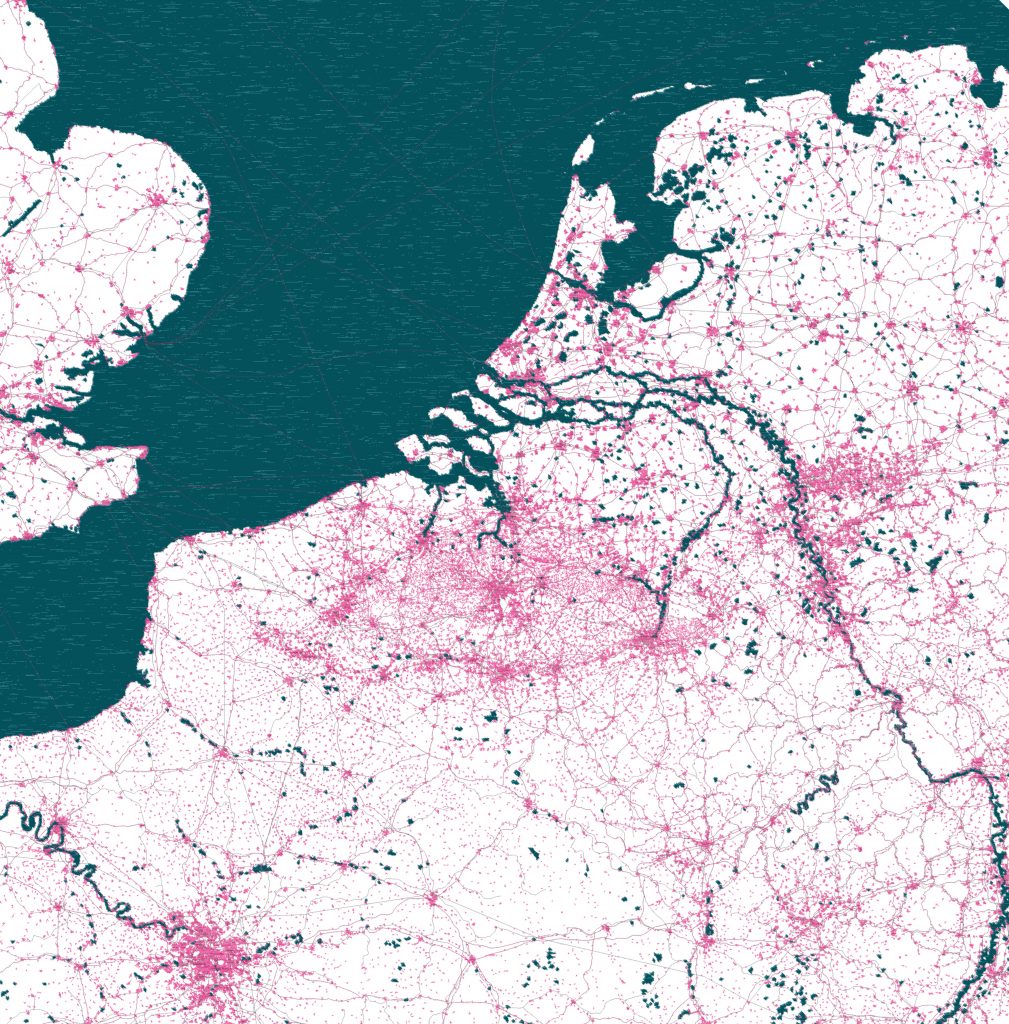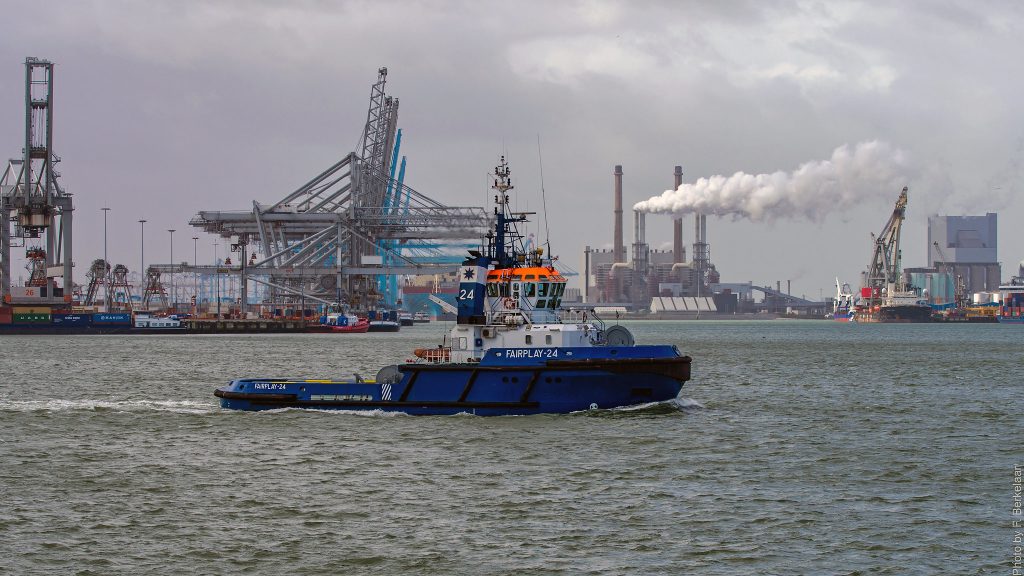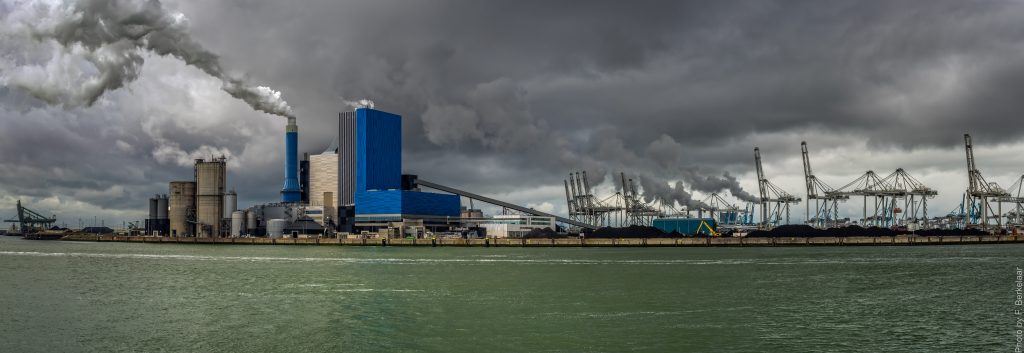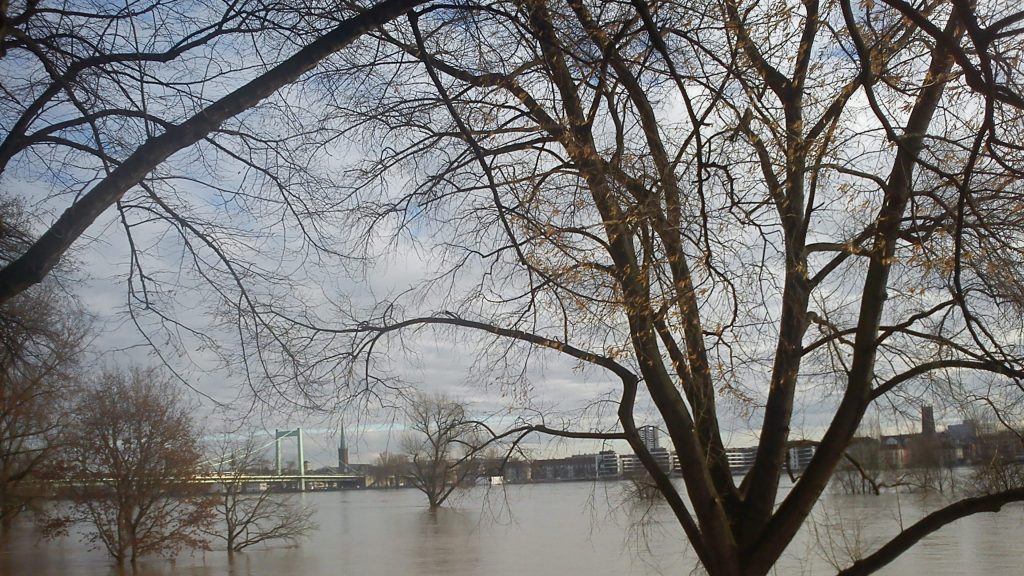The Eurodelta is a densely urbanised megaregion with approximately 45 million inhabitants. It is an area with a common history and mind set, i.e. the Rhineland model [1] (Roadmap SURE-Eurodelta, 2020). With shared challenges and urgencies within this territory on the subject of corridors and transport, it is important to commit towards improving the interrelationship between ports and cities.
The aim of the transport corridor development and high-speed rail network is to improve the synergy and connection between metropolitan regions in North-western Europe by realizing the concept of ‘borrowed size’ [2]. This is in line with finding new and sustainable ways to better connect and integrate the region.
Besides the larger and busier ports like the Port of Rotterdam, Antwerp and Hamburg, a variety of other hinterland and inland ports are equally important to this megaregion. Eurodelta brings forth an interesting combination and division of roles and responsibilities between the seaports and inland ports, addressing a shared sense of urgency. However, they lack a structural framework of collaboration. This article will explore the positioning of Rotterdam as a strong seaport that enables connections to other smaller ports, thus facilitating important port-city relations in the Eurodelta.
Context and urgency
Currently, the territory of the Eurodelta encompasses cities and regions from five countries. The borders of this territory are blurry and not sharply defined due to its vast connectivity of the European waterway-system. Rather than one major city, the Eurodelta is made up of a lot of medium-sized cities which are geographically, culturally and economically interwoven, forming an economic centre and entry way to Europe. About 50% of the total trade of the region goes between at least two of the three regions, making it an important scale to address the common challenges of the delta. It represents a core region in Europe with shared values and challenges and is embedded in a network of transnational transport corridors (TEN-T) [3]. Additionally, seaports are essential for the ‘Blue Economy’ and for maintaining global trade and development, with the port of Rotterdam at the forefront. The latter is a global hub for the trade of goods, services and knowledge, but at the same time, transport (particularly through the ports) is responsible for a large share of CO2 emissions in the region. Therefore, decarbonising the maritime transport sector and ensuring sustainable and circular flows is crucial moving forward.
This is urgent not least because ports like Rotterdam are particularly exposed to various impacts of climatic hazards, such as rising sea levels, storm surges, waves and winds, riverine and pluvial flooding etc. due to their seaside location (UNCTAD, 2021). These major events are expected to increase in intensity and frequency according to future climate predictions and scenarios. Increased sea-levels due to global climate change pose a critical threat to the sustainability of future port and port-city regions. Thus, the physical and economic damage of such climate-related extremes will adversely affect the functionality of ports and liveability in port-city regions.

Strengthening collaborations and economic instruments can help provide flexibility in addressing the negative environmental impacts of climate change – especially related to shipping and port activities. However, a lack of global framework, and transnational cooperation such as monitoring and enforcing (for example, a tax on the real SO2, NOX, or noise emissions from each ship) make it difficult for ports to take concrete actions in addressing climate change impacts (Woo et al., 2018.). Thus, regional cross-border collaboration particularly at the Eurodelta scale as well as cooperation between the inland ports is a crucial step in dealing with global climate change impacts.
Ports as drivers for urban and regional growth
Regional urbanization in the Eurodelta has produced economic growth and urban sprawl. This leads to spatial impacts on local development, which is undergoing severe stress due to lack of space, with irreversible impacts for port development.
Due to port regionalization, imbalances in port capacity and the competition in broader geographical regions form the key drivers of cooperation between ports. Congestion reduction in and around port areas is expected to enhance balanced multimodal transport solutions (Lonza & Marolda, 2016). Therefore, it can be argued that cross-border and inter-metropolitan cooperation between ports can contribute to achieving the targets for sustainable growth for 2030 and 2050 faster (Inception report, ESPON STISE, 2021). It is necessary to have policy and governance cooperation to develop future territorial policies regarding sustainable maritime transport infrastructure. Ports and port-city regions in the Eurodelta are key players in achieving sustainable growth (incl. air quality, climate and energy targets).

Green Ports: Efficient production contributes to a sustainable economy
The ambition of the European Commission is to develop sustainable transport in Europe by reducing CO2 emissions by 60% between now and 2050 and by establishing a 30% modal shift to rail and waterways. The growth of electricity-powered operations in ports (e.g. green hydrogen) can be a key driver in bringing down emissions. Stakeholders in the port community are increasingly investing in greener technologies to run production more efficiently. Endorsed by the Dutch Ministry of Infrastructure and Water Management, the initiative RH2INE seeks to realise market-ready hydrogen applications along one of EU’s oldest core network corridors, i.e. The Rhine-Alpine Corridor. To realize such transformational differences for ports, digital investments are necessary. Understanding the port’s carbon footprint and how to reduce power and space consumption of all port stakeholders is key to a sustainable economy. Ports can make investments in ‘Just in Time (JIT)’ arrival by communicating relevant information, so that the handling of goods can be optimized. Broadly, it can be argued that the formation of regional port associations (joint ventures) along core waterways are on the rise because they offer tri-modal transport solutions which allow for bundling of capacities and operations and strengthen their position towards sea ports like Rotterdam, Antwerp and Hamburg.

Climate strategies enforce environmental sustainability in port cities
In terms of environmental sustainability, waterfront cities along the Rhine are experiencing growing challenges in relation to climate change. In the exemplary case of Deutzer Hafen, an old industrial harbour area in Cologne, Germany, the port area is planned to transform from industry to a lively and sustainable neighbourhood, integrated into the cityscape. By meeting the water design challenge, the new planning of the neighbourhood showcases examples of how water challenges and port infrastructure can be turned into water resources on an urban scale (COBE, 2021). Similarly, Liège Trilogiport, a tri-modal logistic area of 100 ha located along the Albert Canal, forms a buffer between the logistic platform and inhabited areas. In this zone, community gardens, biking paths, and walking areas coexist through a state-of-the-art environmental approach which was developed in collaboration with residents’ representatives (ConnectingCitizensPorts21, 2021). In this regard, it is important to emphasize the strong will and ambitions of project stakeholders (coalition of the willing), who are committed to combining economic development, citizen’s well-being and preservation of the living environment.

Conclusion
To conclude this discussion paper, three strong directions from a research and practice point-of-view are recommended:
- Laws and regulations tend to obstruct sustainable port-city relations and projects. The local and national government hold a tremendous responsibility towards the cross-border exchange as well as creating beneficial relations with the adjacent regions (Daamen and Vries, 2013).
- Innovation, knowledge transfer and exchange – Emphasize port development research and cross-border collaboration within Eurodelta. The main focus should be on creating the narrative, tools and community of knowledge.
- Collaboration at three scales, domestic (between the port and the city/regions), horizontal (between port cities to port-city regions) and vertical (between seaports and inland ports).
All these directions answer to “How can collaboration of Eurodelta ports spearhead in taking actions to address climate change?” By sharing some of the inspirations and best-practice examples, the aim of this article is to create a sense of urgency among all Eurodelta ports. This is the first step to strengthen their identity as port cities and promote port-city-regions to shape their accessibility and visibility in the megaregion and in Europe. A strong collaboration between inland ports and seaports (such as Rotterdam) is necessary for the development of hinterland connectivity and regional networks, thus enabling the green transition in the Eurodelta.
Head Image | View of Port of Rotterdam and Kop van de Beer. (© Danny Cornelissen; Source: Port of Rotterdam Authority, 2020).
Notes
[1] The Rhineland model is defined as a management approach based on concepts of cooperation, consensus, social justice, and serving the interests of multiple stakeholders with long-term sustainability of a main goal.
[2] ‘Borrowed size’ is an emerging policy concept in several European countries. It occurs when a city or metropolitan region possesses urban functions and/or shares economic/ spatial/ infrastructural benefits normally associated with larger regions. This is enabled through interactions in networks of cities across multiple spatial scales.
[3] The Trans-European Transport Network (TEN-T) policy addresses the implementation and development of a Europe-wide network of railway lines, roads, inland waterways, maritime shipping routes, ports, airports and railroad terminals. The ultimate objective is to close gaps, remove bottlenecks and technical barriers, as well as to strengthen social, economic and territorial cohesion in the EU.
References
Aarts, M., Daamen, T.A., Huijs, M. & De Vries, W. (2012), Port-city development in Rotterdam: a true love story, in Urban-e, 2 (3), 2012.
COBE (2021), Nordhavn Denmark Architects. Elected design office for Deutzer Hafen in Cologne. https://cobe.dk/idea/deutzer-hafen (accessed on 29.9.2021).
ConnectingCitizensPorts21 (2021), (online). Available at: https://www.citizenports.eu/intro/awareness-acceptability/project-of-the-port-of-liege/ (accessed on 1.10.2021)
Daamen, T.A. and Vries, I. (2013), Governing the European port–city interface: institutional impacts on spatial projects between city and port, in Journal of Transport Geography, 27, pp.4-13.
Den Boer, E. and Verbraak, G. (2010), “Environmental impacts of international shipping. A case study of the port of Rotterdam”.
Lonza, L. and Marolda, M.C. (2016) Ports as Drivers of Urban and Regional Growth, in Elsevier, Transportation Research Procedia, Volume 14, 2016, Pages 2507-2516.
Port Technology (2021), in PTI Journal Edition 105 (online). Available at: https://www.porttechnology.org/news/what-is-a-green-port/ (accessed on 30.9.2021).
STRING Network (2021), (online). Available at: https://stringnetwork.org/a-future-proof-sustainable-economy-the-north-european-megaregion/?utm_source=rss&utm_medium=rss&utm_campaign=a-future-proof-sustainable-economy-the-north-european-megaregion (accessed on 29.9.2021).
Roadmap SURE-Eurodelta (2020), Strategic Urban Region Eurodelta – SURE Network.
Upper Rhine Ports (2021), Ergebniszusammenfassung des TEN-T-Projekts, “Upper Rhine, a connected corridor” (online). Available at: http://www.upper-rhine-ports.eu/ (accessed on 29.9.2021).
Unctad.org (2021), “Climate change impacts on seaports: A growing threat to sustainable trade and development”, UNCTAD (online). Available at: <https://unctad.org/news/climate-change-impacts-seaports-growing-threat-sustainable-trade-and-development> (Accessed 6 October 2021).
Woo, J.K., Moon, D.S. & Lam, J.S.L. (2018), The impact of environmental policy on ports and the associated economic opportunities in Transportation Research Part A: Policy and Practice, 110, pp.234-242.
Zhao, Q., Xu, H., Wall, S. & Stavropoulos, S. (2017), Building a bridge between port and city: Improving the urban competitiveness of port cities, in Journal of Transport Geography, Volume 59, https://doi.org/10.1016/j.jtrangeo.2017.01.014.